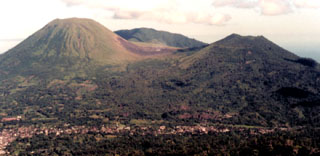Report on Lokon-Empung (Indonesia) — 6 July-12 July 2011
Smithsonian Institution / US Geological Survey
Weekly Volcanic Activity Report, 6 July-12 July 2011
Managing Editor: Sally Sennert.
Please cite this report as:
Global Volcanism Program, 2011. Report on Lokon-Empung (Indonesia) (Sennert, S, ed.). Weekly Volcanic Activity Report, 6 July-12 July 2011. Smithsonian Institution and US Geological Survey.
Lokon-Empung
Indonesia
1.358°N, 124.792°E; summit elev. 1580 m
All times are local (unless otherwise noted)
CVGHM reported that during 28 June-9 July white plumes rose 50-400 m above Tompaluan crater, in the saddle between the Lokon-Empung peaks, and gray ash plumes rose 100-500 m above the crater. An ash eruption on 10 July produced white-to-gray plumes that rose 200-400 m above the crater. Fluctuations in the sulfur dioxide gas emission rate were noted during 30 June-10 July. Based on gas flux, seismicity, visual observations, and hazard assessment CVGHM raised the Alert Level to 4 (on a scale of 1-4). On 11 July, the Darwin VAAC reported that ash plumes detected in satellite imagery rose to an altitude of 1.5 km (5,000 ft) a.s.l. and drifted NW. According to news articles, close to 1,000 residents were evacuated from the area during 11-12 July.
Geological Summary. The Lokong-Empung volcanic complex, rising above the plain of Tondano in North Sulawesi, includes four peaks and an active crater. Lokon, the highest peak, has a flat craterless top. The morphologically younger Empung cone 2 km NE has a 400-m-wide, 150-m-deep crater that erupted last in the 18th century. A ridge extending 3 km WNW from Lokon includes the Tatawiran and Tetempangan peaks. All eruptions since 1829 have originated from Tompaluan, a 150 x 250 m crater in the saddle between Lokon and Empung. These eruptions have primarily produced small-to-moderate ash plumes that sometimes damaged croplands and houses, but lava-dome growth and pyroclastic flows have also occurred.
Sources: Pusat Vulkanologi dan Mitigasi Bencana Geologi (PVMBG, also known as CVGHM), Darwin Volcanic Ash Advisory Centre (VAAC), Associated Press

